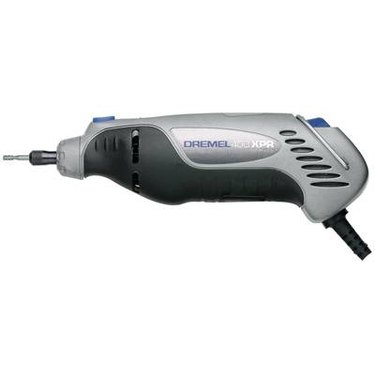
The Dremel XPR rotary hand tool is a great tool for many types of professionals and craftsmen to own and use often. Even the arts and crafts enthusiast will have a great time using this tool while being able to accomplish tasks that would be more difficult with other tools. The Dremel 400 XPR is designed to accept any Dremel attachment, including the Work Station, the Routing attachment, and the Flex Shaft attachment. There are also two XPR attachments designed to be used exclusively with the Dremel 400 XPR: the XPR Planer and the XPR Multisaw. These exclusive attachments harness the power and performance of the Dremel 400 XPR to provide results where other tools can't.
Step 1
Choose an accessory that is appropriate for the task you need to complete. For example, to sharpen an axe, use an aluminum oxide grinding stone; to cut a galvanized plumbing pipe, use a reinforced cut-off wheel; to cut a hole in drywall, use a drywall cutting bit. There is an attachment for just about every task.
Video of the Day
Step 2
The switch setting will determine how fast the accessories spin: - Setting 2: 5,000 - 8,000 RPM - Setting 4: 9,000 - 11,000 RPM - Setting 6: 12,000 - 17,000 RPM - Setting 8: 18,000 - 24,000 RPM - Setting 10: 25,000 - 35,000 RPM For grinding stones, setting 8 is recommended; for cutting pipe, setting 10 is recommended; to cut drywall, setting 8 is recommended. Using the recommended cutting speed will help the tool do its job the way it was designed to do it. Note: Polishing, buffing, and wire brushing should be done at slower speeds (below 15,000 RPMs). Wood cutting, drilling, carving, etc. should be done at higher speeds (15,000 RPMs or more). Allow the performnce of the tool do the work. Do not force the tool if it is not performing the way you think it should. Use a different accessory or speed setting to complete the task.
Step 3
Clean the tool when the project is complete. Unplug the tool and blow the dust off of the tool. If you have an air compressor, use it to blow the dust off of the tool and out of the vents. Wipe the tool down with a damp cloth rag, and then store the tool in its tool case. Be sure to lock the lid!
Warning
Running your Dremel tool with worn brushes will permanently damage the motor. Replace the motor brushes regularly as needed.
Video of the Day